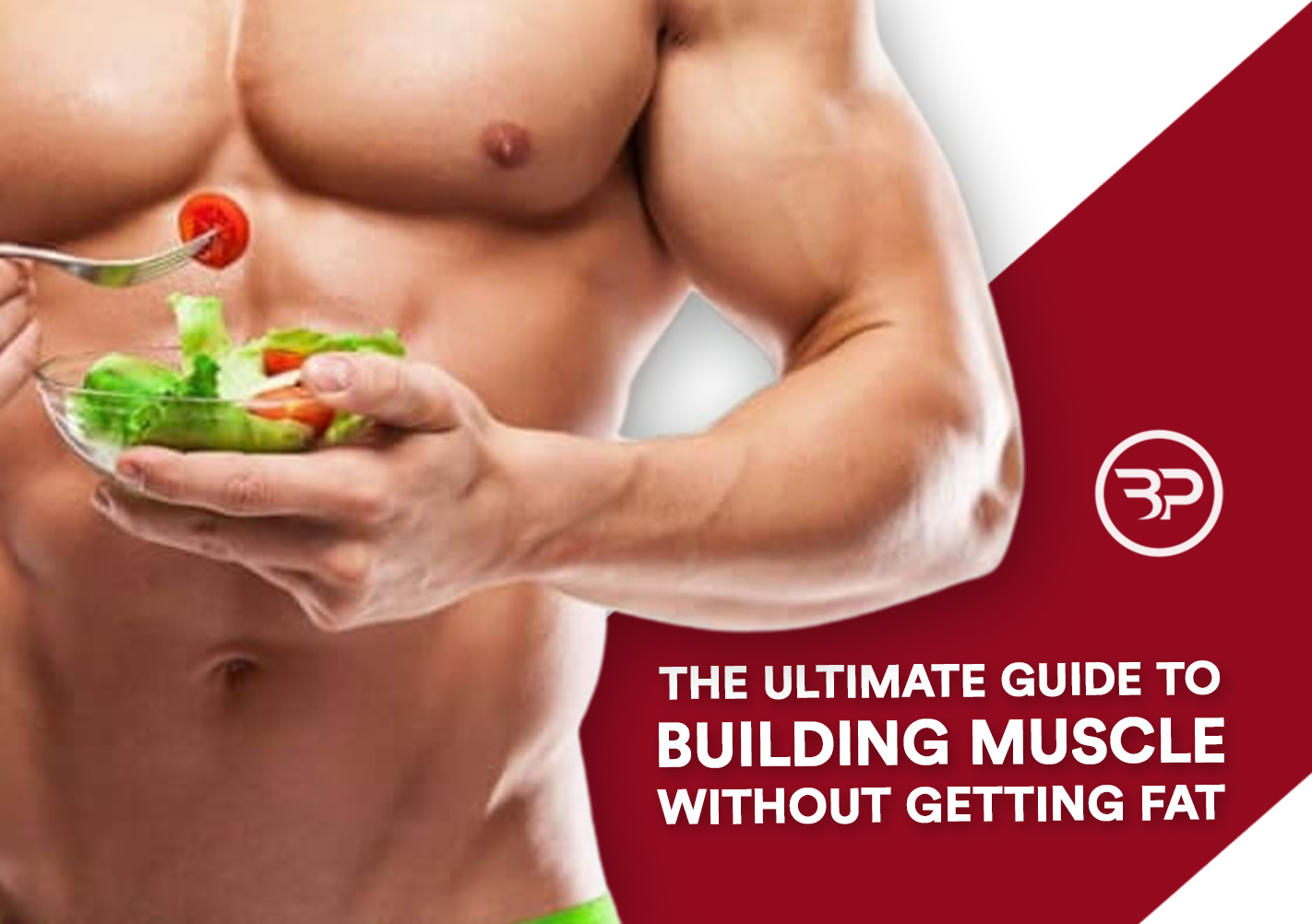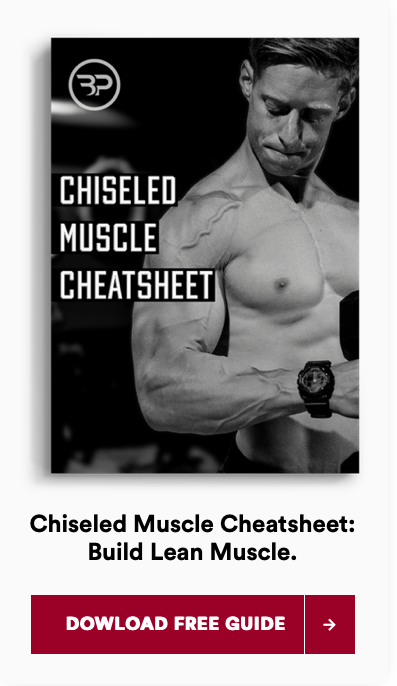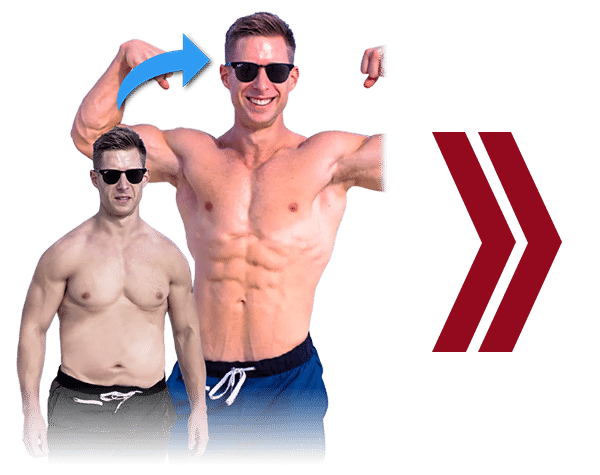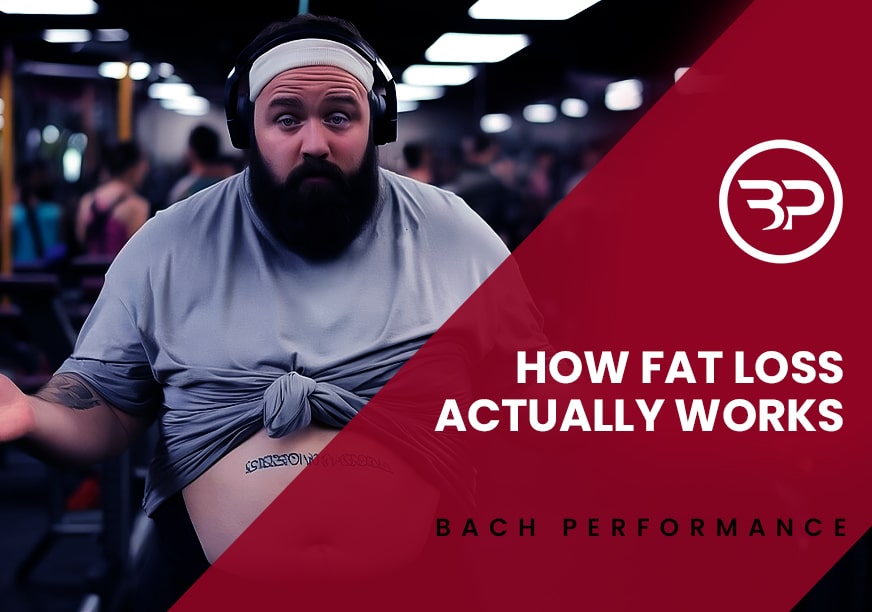The Ultimate Guide To Building Muscle Without Getting Fat
August 16, 2021
If you want to add muscle without gaining fat or using steroids, you’ve come to the right place: The Ultimate Guide To Building Muscle Without Getting Fat.
Below you’ll discover:
- The right blend of heavy strength work, higher-rep, bodybuilding exercises, and even (gasp) cardio to optimize muscle building without getting fat.
- The four models that outline how much muscle you can build naturally. This is humbling, to say the least.
- How to build lean muscle with minimum fat gain. I’ll give you a hint, avoid the biggest muscle-building mistakes, follow a slight caloric surplus, and follow the step-by-step plan we outline instead.
And, if you want a proven plan to take the lessons from this article and put them into place so you can start adding lead muscle without gaining body fat…Grab Our Chiseled Muscle Cheatsheet: Chiseled Muscle Cheatsheet.
How To Bulk Up Without Fat Gain
Flashback to the young Eric. If this were a movie, you’d be hearing weird, ethereal music now as we dissolve to grainy black and white footage of my 19-year-old self.
Burrrrrrrrp.
I guzzle another protein shake mixed with mint-chocolate chip ice cream.
Oh, the sheer gluttony.
I sigh in relief as my gut rumbles and sit back on the couch. 3,000 calories already consumed, but another 2,500 left to “eat”.
I’m in the thralls of a “dirty bulk” and on the see-food diet.
That means if I see food, I eat it. I make it a habit to devour every calorie-containing-morsel insight. I move only when needed.
After all, conventional wisdom says the more you eat the muscle you can gain, right?
Wrong.
You see, as a former 103-pound runt I wanted nothing more than to be big, strong, and muscular. After I stopped playing football, I continued to lift and eat everything in sight.
But soon…
My stomach ached. I become lactose intolerant from drinking so many dairy-based protein shakes. Even worse, I spent winter break in the doctor’s office trying to figure out why my gut hurt and why I kept droppin’ bombs.
Sexy, right?
My weight crept up by 25 pounds over the course of three months.
Instead of being healthy, strong, and lean I looked and felt like crap.
And guess what I was studying in school? Yeah, binge drinking kinesiology. Ironic, huh?
But I digress. The point is I was not alone.
Before setting any goal you must know what’s physically possible.
After all, a 5’6″ man can’t expect to guard Shaq in the low-post as an NBA center. And an average guy can’t expect to train, eat, and look like a stage-ready bodybuilder.
Setting Expectations: How to Bulk Without Gaining Fat
Those struggling to lose weight obsess over scale weight. So do anxious bulkers. They’re both wrong.
Remember: the goal is to add lean muscle, not weight.
To quote the great Vince Gironda, “If you don’t like what you see in the mirror, what difference does it make what the scale says?”
For many guys who want to look bigger, it’s all about getting lean first. Their ideal is 10% body fat or lower. Achieve this and you’ll look better and build muscle more efficiently.
If you’re a skinny-limbed dude, be realistic about your expectations.
Can you really expect to develop the body of an NFL running back? The average 5’7 to 6’0″ guy looks much better at 165-185 pounds and 8-12% body fat than at 200-plus pounds at 15% body fat or higher.
Track your waist, chest, arms, and thighs every two weeks. Snap progress photos. The combination of measurements, photos, and the scale paints a clear picture.
They’re completely focused on building their bodies. They eat, sleep, and train to be in great shape. This is a luxury most busy men and women (read: you) with 9-5 jobs, a family, and a commute don’t have.
Consider the following before setting your goals:
Many men see pro athletes and magazine covers and decide, “This is what I want to look like.” Yes, it’s great to set high goals and push yourself, but you must understand three factors that differentiate these folks.
First, they’re completely focused on building their bodies. They eat, sleep, and train to be in great shape. This is a luxury most busy men and women (read: you) with 9-5 jobs, a family, and a commute don’t have.
Second, While less important but still relevant, a good chunk of these folks use performance-enhancing drugs like steroids.
Third, most athletes and pro-bodybuilders have superior muscle-building genetics. They’re the exception, not the expectation you should have for yourself.
Trying to emulate genetic outliers or geared up bro’s is a mug’s game.
But that still leaves the question:
How much muscle can you gain naturally without gaining unwanted body fat?
Muscle Models: How To Bulk Without Gaining Fat
You’re the average, busy dude with a family and obligations outside of eating, sleeping, and flexing your biceps. How much muscle can you gain? Here are some of the leading models from leading authorities.
Model #1: Alan Aragon
Alan Aragon, the researcher, and author who runs the Alan Aragon Research review provides a clear-cut breakdown of the maximum rate of muscle gain, here:
Example: Jake is a 25-year-old busy dude who hasn’t lifted since high school. He weighs 140 pounds.

Year One
140lbs x .0125% = 1.75 pounds per month = 21 pounds per year.
If Jake eats enough calories, trains 3-5 times per week, and sleeps 6-8 hours per night he can gain about 21 pounds in year one.
Year Two
161 lbs X .0075% = 1.2lbs per month or 14 pounds in a year. Jake is still gaining at an impressive rate.
Year Three
175 lbs x 0.0037 = 0.65lbs of muscle per month, or 7.7 pounds in a year.
This puts Jake at the maximum weight of 182 or 183 pounds. Yes, he can continue to gain muscle after this, but it will be slow.
Bottom Line: Your muscle potential decreases each year you train. Progress slows and tops out around 40-50 pounds of lean muscle total.
Model #2 The Lyle McDonald Genetic Muscular Potential Model
Lyle McDonald, researcher, author, and head honcho at Body Recomposition has a similar model.
The rates of lean muscle gain growth slow dramatically the longer you train. Like Aragon’s model, there is a cap at 40-50 pounds of lean muscle for men. The cap for women is about 20 pounds.
Age also plays a role. A 30 or 40-year-old person will struggle to gain as fast as an 18-year-old male with the testosterone of a raging bull.
Lyle also drops these words of wisdom. “After seeing a pro bodybuilder stepping on stage at 260 pounds or more and shredded, the idea that a natural may top out at 180-190 pounds of lean body mass (if that) can be disheartening.

Of course, to the general public, an individual at a lean 180-190 pounds is still pretty enormous. It’s just that compared to the absurd size of a pro bodybuilder, it seems absolutely tiny. But it is reality.”
The Bottom Line: Reality check time. There’s a damn good chance you’ll look your best between 165 pounds and 185 pounds, and not at the size of a professional bodybuilder.
Lyle’s model indicates your muscle gains slow dramatically after your initial training. If you start lifting at your hormonal peak in young adulthood, males can expect to gain 40-50 pounds without drugs, and females half that.
Finally, people with bigger joints and a bigger overall bone structure may have greater genetic hormonal advantages to build lean muscle compared to my skinny-limbed, narrow jointed brethren.
Model #3: The Casey Butt Equation
Casey Butt, Ph.D. is a natural bodybuilder who’s analyzed the frames of thousands of bodybuilders to determine the maximum muscular potential for steroid-free lifters.
His formula is the most complicated and is based on the idea that bone structure plays a significant role in how much muscle you can gain. By measuring the size of your wrists and ankles you can determine how much lean muscle you can gain with this equation.
If you stumbled on this in High School math class you bright shriek in sheer terror:
Yikes, right?
The Bottom Line: If you’re a skinny, small-jointed dude like most hard-gainers you simply can’t build as much muscle as thick-jointed people.
Bigger jointed humans can build more lean muscle because they have the support. But don’t despair if you are smaller jointed. Your gains may end up looking more dramatic. You’ll appear more muscular than your scale weight indicates.
Model #4: The Francis Holway in the Sports Gene
Similar to Casey Butt’s model, this model relates muscular potential to bone structure. “Like muscle, bone responds to exercise and repeated stress.” Repeated stress builds bone, which increases your ability to carry more lean muscle.
Stronger by Science explains:
“In measurements of thousands of elite athletes from soccer to weightlifting, judo, rugby, and more, Holway has found that each kilogram (2.2 pounds) of bone supports a maximum of five kilograms (11 pounds) of muscle. Five-to-one, then, is a general limit of the human muscle bookcase. The limit for women is closer to 4.1 to 1.”
The Bottom Line: You can build bigger, denser bones through repeated training. While you have a limit to how much muscle your frame can support, heavy lifting can indeed build muscle and give you a bigger frame. And a bigger frame leads to more muscle growth.
Making Sense of It All
Here are the two key points:
(1) The longer you train correctly the less muscle-building potential you have. Sorry, you can’t have newbie gains forever.
(2) Your bone structure plays a role in how much muscle you can build.
(3) There is a limited speed at which you can grow muscle. Find out exactly how much muscle you can build and how fast by reading here.
But don’t use the “I’m a skinny hard gainer” as a crutch if you’re a naturally narrow jointed dude. You can still build an impressive physique.
So focus on what matters:
- Training hard and consistently.
- Sticking to a muscle-building diet.
- Getting enough sleep to recover from hard training.
And for god’s sake…
Click Here to Grab a Free Copy of The Chiseled Muscle Cheatsheet
The Worst Muscle Building Diet If You Want To Stay Lean and Healthy
All the dumb fitness ideas the classic “dirty bulk” is one of the dumbest. With so much competition, that’s quite a statement.
The classic dirty bulk leaves you devouring fast food and weight gainer shakes like it’s going out of style.
The focus is all on consuming more calories to gain as much size as possible. While you’ll gain plenty of muscle, much of it will be fat.
What’s the point in bulking if you look worse?
There isn’t one.
After all, you want a big chest, arms, and strong legs, not flabby love handles, sagging tits pecs, and a beer gut.
Why should you avoid the classic dirty bulk? Let me count the ways, then suggest what to do instead to get jacked, stay jacked, and live happily ever after.
First, the fabulous five fails.
(1) Consuming Too Many Calories
(2) Fat Hyperplasia (Teaser Alert: This Is Bad)
(3) Decreased Insulin Sensitivity (Also Bad)
(4) Developing Shitty Habits
(5) Rushing the process
Consuming Too Many Calories
You only need a calorie surplus of about 10-20% to build lean muscle.
Eating 5,000 calories per day works for lifters on a boatload of steroids, but not the average guy.
For the natural, drug-free lifter your body can only grow so fast. Eating everything in sight will simply lead to more fat gain, not more muscle.
Eat 300-500 calories above maintenance and you’ll gain lean muscle, not fat.
This is 1-2 protein shakes and a banana or two per day above maintenance calories. Alternatively, this is an extra sweet potato and a chicken breast each day, not a 1200 calorie burger from the fast-food joint.
Fat Hyperplasia
When you overeat your body increases the number of fat cells your body stores as a survival mechanism.
This is called fat hyperplasia, which makes it more difficult to lose fat going forward. The big kicker here is you can’t eliminate cells, you can only make them smaller.
Following a dirty bulk will make you fatter. It will make it easier for your body to store fat in the future. Worse, it will make it harder to lose unwanted fat in the future.
I’ll pass. I recommend you do the same.
Decreased Insulin Sensitivity
At any moment you’re either burning fat or building muscle.
The switch behind this?
Insulin.
When you’re sensitive to insulin, your body effectively burns stored body fat and breaks your food into energy.
Insulin stimulates protein synthesis, inhibiting the breakdown of protein, and transforms amino acids into your muscles. Insulin is an extremely powerful muscle-building hormone.
But here’s the problem: most people have poor insulin sensitivity. This makes it damn near impossible to add lean muscle without adding a spare tire on the side.

When you follow a dirty bulk you’re constantly pounding your body with food, forcing insulin to work double-time. This causes three problems.
(1) You’re never giving your digestive system a break. This makes it hard to digest the food you’re taking in.
(2) When you’re constantly eating, especially carb-based meals, you’re spiking insulin repeatedly. You want to spike insulin strategically, like post-workout to maximize lean muscle and not build fat.
(3) You’re more than likely gaining fat on a dirty bulk. This decreases your insulin sensitivity, making it harder to build muscle and lose fat.
Your best option is to follow a clean eating plan. Progress will be slower, but you’ll build big muscles, not a big gut.
Developing Bad Habits
Yes, guzzling mass gainer shakes and drinking a gallon of milk per day increases scale weight. But the scale doesn’t matter if you don’t like how you look in the mirror.
Don’t use the excuse “I’m bulking, bro” to eat like a spoiled six-year-old.
You’re developing tough-to-break habits while doing irreparable harm to your body.
Keep your eye on the ball.
Play the long game.
Rushing The Process
There’s a limit to how quickly you can build muscle.
More food doesn’t equal more muscle. Eat slightly more calories than you need, rather than emptying the fridge.
There’s a limited amount of muscle you can gain at any given time.
The 8 Crucial Keys To Building Muscle Without Getting Fat
Time and consistency are key.
If you’re serious about building muscle without getting fat, you need to commit to a 3-6 month program and not a month of bulking, followed by a month of cutting.
Remember: the muscle-building process is slow, likely 2-3 pounds of muscle MAX per month when you’re eating and training well, and getting plenty of rest.
Stay the course and hammer the following 8 things.
First, the list. Then, more details about each.
- Eat For a Slight Caloric Surplus
- Eat Mostly Clean
- Eat High protein and Relatively High Carbs
- Time Your Carbs
- Take a “Diet Week”
- Lift Heavy and Get a Pump
- Do the Right Kind of Cardio
- Lose Unwanted Fat Before You Bulk
1. Eat For a Slight Caloric Surplus
You have a maintenance calorie intake to keeps your body weight level. To build muscle, you want to eat 400-500 calories above this number. This is a far cry from the “eat everything in sight” diets that have you adding excessive amounts of body fat.
Find out how many calories you need here:
Bodyweight (lbs.) x 16 + 500 calories
So, 160 lbs x 16 + 500 = 3060 calories
A 160-pound guy would eat about 3060 calories. Now, understand this number isn’t set in stone and there is no one-size fits all equation. Chances are, you’ll need a little more or a little less. Either way, track your calories with an app like myfitnesspal. Get consistent with your muscle-building diet.
If your weight isn’t increasing, eat an extra banana or try one of these muscle-building shakes to your diet.
You need to eat more calories than you burn, but not by much. Aim for a slight caloric surplus and you’ll give your body the fuel to build muscle while limiting fat gain.
2. When It Comes To Building Muscle Without Getting Fat, Eat Clean
You don’t need to haul food containers in a cooler and choke down dried chicken breast and broccoli all day.
But you shouldn’t be spending your afternoons crushing Baconators and using bulking as an excuse turn into a fat slob.
If your body isn’t healthy, who cares how big you are? You’re playing a fool’s game. You’ll fail sooner rather than later.
Most of your foods should have had a face or grown naturally in the ground.
Aim to have a source of protein and a vegetable every time you eat.
As for macronutrients consider the following:
Protein: Provides amino acids, the building blocks for muscle. With each meal eat one of the following:
-lean beef, bison, venison, wild game, chicken, turkey, eggs, and seafood. Baked or grilled is your best bet.
Fats: Essential for healthy hormone levels. (men, you should read this)
You’ll get some from your protein sources. Also consume nuts, avocado, and some oils like coconut and olive oil.
Carbohydrates: Carbs are essential for energy production and prevent the breakdown of muscle tissue for energy. Reduce or eliminate refined crap and most white foods, including flour and sugar. (Rice is an exception.)
The majority of your carbs should come from rice, potatoes, squash, oats, barley, quinoa, 100% whole wheat bread, fruits, and vegetables. These foods provide a boatload of vitamins, minerals, fiber, and antioxidants for both health and performance.
3. High Protein and Relatively High Carbs
You need both sufficient protein and carbs to maximizing muscle building. The amount of protein you need to build muscle is often drastically overstated.
All you need is .82g/lb. -1g of protein per pound of bodyweight.
This means a 160lb guy needs 131g-160g of protein per day.
Can you have more? Sure, but a 2011 study by Phillips and Van Loon found .82g/lb. of body weight to be the upper limit of protein synthesis. In other words, eating more protein won’t increase how much muscle you’ll build.
And carbs?
Everyone’s hopped on the low-carb bandwagon at some point. These diets work well for fat loss, but not building muscle.
Here’s the problem. Carbohydrates are protein-sparing. This means eating carbs will spare your body from breaking down stored muscle tissue to fuel your day.
Eating a moderate-high carb diet helps you keep the lean muscle you’ve already built rather than breaking it down for energy, a key component of building muscle without getting fat.
Further, your workouts will suffer during a low-carb diet. You’ll be lethargic and have terrible pumps. You’ll end up flat and deflated, not pumped and jacked.
Carbs are your friends. They’ll spare the muscle you have, improve your workouts, and help drive nutrients into your cells to maximize lean muscle gains.
Protein intake: Eat .82g/lb. -1g/lb. of protein per pound of body weight, or 131-160g for a 160-pound person. More protein won’t help, more calories will.
Carb intake: Eat 1.5-2g of carbs per pound of bodyweight to maximize lean muscle or 240-320g per day on workout days.
4. Time Your Carbs
If you’re interested in building muscle without getting fat there is one stubborn bastard of a hormone you need to control: insulin.
When you eat carbs, insulin is secreted and your body is in storage mode. That’s perfect for building muscle. But you don’t want to always be in storage mode otherwise you’ll gain fat.
The solution? Cycle your carbs to control insulin so you can build muscle and burn fat on demand. Here’s a more simple approach to carb cycling: Carb Cycling Made Easy.
On workout days eat more carbohydrates throughout the day. Eat oatmeal in the mornings, faster-digesting carbs like rice after your workouts, rice at lunch, and sweet potatoes in the evening. To build muscle you’ll need to boost insulin throughout the day.
On off-days, keep carbohydrates lower, such as 1-1.5g/lb. of body weight. Move most of your carbs into the afternoon and evening. This limits number of insulin spikes throughout the day, promoting fat burning, maintaining insulin sensitivity, and gives you enough carbs to build lean muscle.
As a bonus, moving your carbs into the evening prompts the release of serotonin, a precursor to melatonin to improve your sleep.
5. Take a “Diet Week”
When it comes to building muscle without getting fat I recommend you cycle your calories to maintenance for one week every six to eight weeks.
This helps you in three ways.
- You’ll give your digestive system a break. By dialing back a few hundred calories you’ll give your body time to rejuvenate.
- Increased insulin sensitivity. The more sensitive your body is to insulin the better you’ll be able to minimize fat gain.
- You’ll get a mental break. Eating to build muscle is a job. This break gives you the mental firepower to recuperate and come back full-speed.
What To Do: Multiply your body weight (lbs.) x 16, so a 160-pound person would eat 2560 calories for one week. Then ramp your calories back up. You’ll feel refreshed, should be a little leaner, and ready to dominate another sprint.
6. Lift Heavy and Get a Pump
Use Compound Movements: Want more results in less time? Emphasize big lifts. They’ve been around for a long time. And the reason is simple: They work best.
Lower body: squats (all forms), deadlifts, and lunges
Upper body (chest): bench press, dumbbell bench presses, dips
Upper body (shoulders): barbell shoulder presses, single-arm dumbbell press, push press, seated dumbbell shoulder press
Upper body (back): barbell rows, cable rows, dumbbell rows, pull ups/chin ups, lat pull downs.
Use a variety of rep ranges: If you’re trying to build muscle, you need a variety of rep ranges to improve strength to get stronger and improve your ability to build muscle. This means you need to get strong so you can lift heavier weights for a higher number of reps, and add volume.
Lift Heavy: Train to get stronger. Your muscles require what’s called mechanical tension to grow. You’ll activate more muscle fibers, which helps you get stronger and fatigue those muscle fibers to grow faster. Get stronger on compound exercises with rep schemes like 5×5, 6×3, 4×6, or our favorite: the Minimalist Muscle pyramid rep schemes.
Get a Pump: You know the crazy pump in your arms after biceps curls? This is the pump, an essential component to building muscle.
Pick an exercise and do 3-5 sets of 8-12 reps with 45-60 seconds of rest. Lifting hard without full rest will give you the muscle-building pump.
Create Muscular Damage: Remember the soreness after doing legs for the first time in months, or heck, years? This is muscular damage. This triggers your body to send nutrients to these areas so they come back bigger and stronger. Use 1-2 high-rep finishers like high-rep goblet squats or bodybuilding methods like drop sets to finish your workouts.
7. Do The Right Kind of Cardio
Skipping all cardio when you’re trying to build muscle is a great way to add fat and get out of shape. But any old cardio won’t do.
Go for a walk each day. Take 15-20 minutes after dinner and go for a stroll. If your phone tracks steps, aim for 8,000 steps per day for overall health.
Take 10-15 minutes twice per week and focus and perform some form of high-intensity interval training (HIIT).
Also, try to …
8. Lose Unwanted Fat Before You Bulk
This is one of the best-kept secrets for building muscle without getting fat. You need to get lean first!
Excess body fat works like an organ; pumping out nasty cytokines that increase chronic inflammation and cortisol.
Unfortunately, cortisol also works in opposition of testosterone, increasing fat and making it damn near impossible to build muscle.
Further, the more body fat you have the more likely you are to be insulin resistant. This means your body will have one hell of a time breaking food into usable energy for training and building lean muscle.
So here’s what you need to do. If you’re a man and can’t see a spec of abdominal definition, 15% or so, or a female above 21% body fat you need to lose fat first.
Check what this looks like here: Estimate your percent body fat.
If you don’t? Sure, you can gain 11 pounds, but 7 of them will be fat, not muscle.
Take 8-10 weeks and diet down first. It could be the most powerful way to build muscle instead of fat.
The Final Word On Building Muscle Without Getting Fat
There’s a limit to how much muscle you can naturally build. Your bone structure, habits, and training experience will all play a role.
And as a natural, non-steroid using guy?
You can’t expect to be the size of pro bodybuilder. In fact, it looks like you can expect to gain about 30-50 pounds of muscle if you’re a guy and half of that as a female.
But above all else, your habits in the kitchen, in the gym, and your consistency with both are what determine whether you end up Building Muscle Without Getting Fat or not.
The good news? You can have all of this put together in the clear-cut, easy-to-follow Minimalist Muscle Blitz by heading here.














How much protein on non workout days?
your protein doesn’t change George, like Eric said:
– All you need is .82g/lb. -1g of protein per pound of bodyweight.
This means a 160lb guy needs 131g-160g of protein per day. Can you have more? Sure, but a 2011 study by Phillips and Van Loon found .82g/lb. of bodyweight to be the upper limit of protein synthesis. In other words, eating more protein won’t increase how much muscle you’ll build.
Hope that helps 🙂
Thank you for the assist, Tyson! George, Tyson is spot on. Let me know if you have other questions.
-Eric
I am a 52 year old guy.i have been lifting on and off all my life.i weigh 195 right now.i have a spare tire around my waist.i am finding it very hard to get back to my comfortable feeling weight of 180 to 185. Now that I am older I can’t workout the way I used to.i just want to look good and lean.i feel big and bulky. Can you please help me?
Hi Richard,
Most certainly. Bachperformance.com/coaching is your best bet.
Looking at your struggles, I would ask…have you adjusted your diet? How are you sleeping? These are often more important factors than how you’re training.
Is my calories intake the same on a training day and on a no-training day? Or should I consider adding/eating the calories I burned during workout to my maintenance calorie intake plus the 400-500 surplus?
T – 2560 calories + 400 or 500 + burned calories
NT – 2560 calories + 400 or 500
Is this correct?
Yes, keep them the same for now. There’s no need for unnecessary complexity. Do not worry about the number of calories burned during a workout. Those estimations are nearly always way off, and activity level is already accounted for.
So, 2560+400/500
[…] Rest-pause training is one of the most advantageous ways for you to build strength and size as fast as possible. […]
[…] Without a rep pyramid in place, you’re merely closing your eyes and swinging for the fences, hoping that you’ll hit a home run. But it’s more likely you’ll strikeout rather than building muscle without getting fat. […]
[…] you’ll use fats, carbs, and protein for energy, recovery, and basic bodily functions to build muscle, rather than […]
[…] awesome mobility and athleticism. And they’ll make you hot. Even better, they’ll activate dormant muscles and allow you to see which muscles and joints need to improve for pain-free […]
[…] Sleep improves your body’s ability to regulate insulin and as a result, how well your body uses the calories you eat to build muscle and lose fat. […]
[…] The more often you stimulate a physiological response to training, the more often you boost protein synthesis and anabolic hormone levels to build muscle. […]
[…] must set your expectations in reality. This article will help you gauge what’s […]
[…] you want to look your best, having more muscle mass can help you appear leaner than you […]
[…] 2) Adding more volume per week (added volume = hypertrophy) […]